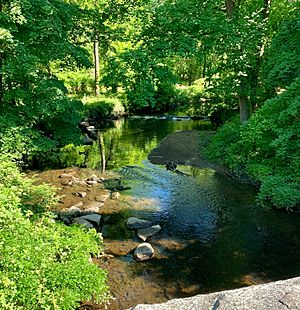Blind Brook watershed facts for kids
The Blind Brook watershed is an important natural area in Westchester County, New York. It's like a giant funnel that collects all the rain and snowmelt from a large area. This water then flows into streams and rivers, eventually reaching the ocean. The watershed covers about 10.91 square miles, mostly in the Town of Rye. It even crosses the border into Connecticut.
Contents
Where is the Blind Brook Watershed?
Most of the Blind Brook watershed (about 96.7%) is in Westchester, New York. A smaller part (3.3%) is in Fairfield County, Connecticut. The journey of the water begins in West Harrison, New York. From there, it flows all the way to the City of Rye. Finally, the water drains into Milton Harbor, which connects to the Long Island Sound.
Understanding Flooding in the Area
This area has often experienced serious flooding. This affects towns like Harrison, Rye, and Port Chester. Back in 1968, an environmental expert named Edith Gwynne Read pointed out a problem. She said that communities needed to work together to find solutions for the already very wet watershed.
Heavy rain is a natural cause of flooding. However, human activities have made it worse. During the 20th century, a lot of new buildings and roads were built. These are called "impervious surfaces" because water cannot soak into them. This means more water runs off quickly, leading to more flooding. In 1980, people in Rye blamed large office parks for increasing flooding. These included places like SUNY Purchase and Texaco.
After a big storm in 2007, the US Army Corps of Engineers studied the area again in 2008. They reported that the worst flooding in Rye happened in 1972 after Hurricane Agnes.
How Westchester County Airport Affects Flooding
Westchester County Airport was built in 1942. Its original purpose was to protect the Rye Lake Reservoir during wartime. This reservoir helps supply New York's drinking water. However, water runoff from the airport eventually flowed into the Blind Brook watershed.
In 2011, there were plans to expand the airport. This led to more questions about how development might harm the environment. Officials asked for a study to map all the wetlands around the airport. They also wanted to check if wetland boundaries had changed. This helps protect these important natural areas.
Discovering Ancient History (Archaeology)
Parts of the watershed are very important for archaeology. This is the study of human history through digging up old objects. People have found many signs of Native Americans living here. Relics and burial sites were discovered in the Blind Brook area in 1855 and 1867.
In 1972, a construction vehicle accidentally found human bones while preparing a building site. Archaeologists came to examine the burial site. They found over 50 pieces of pottery. These pieces were from a time period called the Clason's Point phase. This discovery site is close to another important archaeological spot, Marshlands Conservancy.
Wildlife and Nature
The Blind Brook watershed is a special place for plants and animals. Some parts of the watershed had been damaged by erosion. But the Westchester County Planning Department has worked to restore these areas. This has made the water cleaner and created better homes for wildlife.


